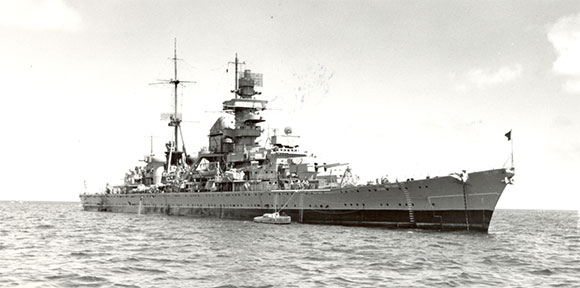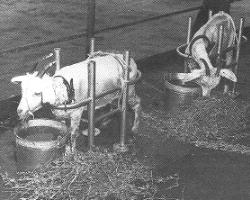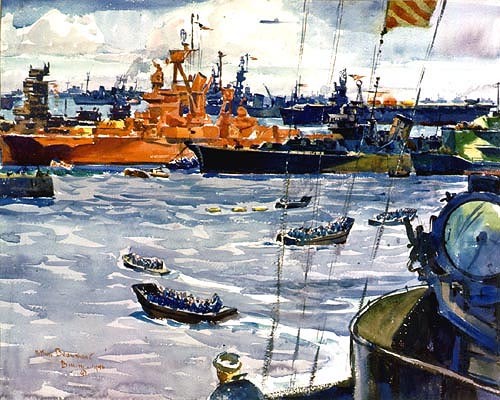
(Ex-Prinz Eugen in the lagoon at Bikini. Photo USN).
The Navy Brass wanted to compare and contrast the survivability of both American and Axis ships, which is why the Nazi Hipper-class heavy Cruiser Prinz Eugen was brought all the way from Europe for the test. By the time she arrived at Bikini, she was officially known as USS IX 300, which is the oddest ship name I have seen in my time in the Navy. I have to say she was a handsome ship when I saw her riding at anchor.
I got plenty of swimming and snorkeling in the lagoon near the big coral head with my associate, the enormous Moray Eel during the three weeks that passed between our arrival and the test. The lagoon was bustling with activity, just as it had been when the Pacific War swept over this usually placid place.
Nagato was part of a fleet of 95 target ships, anchored with military precision near Bikini Island at the eastern end of the vast lagoon.
The center of the formation was USS Nevada, the proud survivor of the attack on Pearl Harbor whose services were not longer needed. It was a little strange to be casually throwing away such powerful ships, but I have always believed that men ‘o war are nothing more than smelted iron oxide trying successfully return to that natural state.
There was a practical reality, too. The Navy Department had a whole fleet of new ships and the old ones were going to either be decommissioned or discarded, or they would break the bank in trying to maintain them in operational condition. So, away they would go.
Ninety-five ships were designated as targets for the ABLE blast. In addition to our little Japanese convoy, and Prinz Eugen, there were four USN battleships, two aircraft carriers, a brace of cruisers, eleven Destroyers, eight Fleet submarines and a host of auxiliaries and amphibious craft. Some of the latter were beached to demonstrate the effect of atomic blast on a simulated landing force. All the ships were laden with sample amounts of fuel and ammunition, plus scientific instruments to measure air pressure ship movement, and radiation.

(Goat #53. the animals were only penned on the ships in the final hours before the test by the last people off the target ships. Photo USN).
We read in the newspapers that eventually made it out to lagoon that there were complaints about the live animals that had been brought out to ride the ships during the tests. I had not heard of “humane activists” for animals before, but obviously we could not ask American sailors to be exposed to the blast, and an acceptable substitute was deemed to be a few hundred pigs, guineas pigs, goats, rats, mice and insects to be placed on the target ships. Some of the pigs were even equipped with their own “flash Suits” like the ones the Navy had developed for shipboard use to evaluate their effectiveness.
All this was supported by a surface force of more than 150 ships that provided quarters, experimental stations, and workshops for most of the 42,000 Army and Navy personnel. Navy made up the vast majority of the Joint Task Force (37,000) and we had 37 female Navy Nurses, a ratio that worked out to one lady for each one thousand sailors.
You can bet they were pretty popular!
Additional personnel were located on nearby atolls such as Eniwetok, where we had our repairs done, and Kwajalein.
It was a big deal, and an honor to be part of it. Navy personnel were allowed to extend their service obligation for one year if they wanted to participate in the tests and see an atomic bomb explode. The papers back home were promoting this as being something between Doomsday and the Fourth of July celebration.
B-17s and B-29s roared over the lagoon in practice formations for the test. Gallant old Nevada was painted a bright red with her gun tubes painted a bright white in order to give the Air Corps bombardier the best target presentation.
Around her, at the center of the target cluster, the density was 20 ships per square mile, which in my experience was three or four times greater than what combat doctrine would recommend. The stated goal was not to duplicate a realistic anchorage, but to measure damage as a function of distance from the blast center, at as many different distances as possible. The arrangement also reflected the outcome of the Army/Navy disagreement about how many ships should be allowed to sink, which was part of the underlying inter-service rivalry that was bubbling fiercely over what roles the Military Departments would have in the Atomic Age.
There were even some people that thought there should be a completely new service created out of the Air Corps, intended to deliver the A-bomb anywhere on earth.
I saw some of the combat art that was created as part of the big publicity coverage of the event. LCDR Art Beaumont did an oil painting of us being evacuated from the ships the afternoon before the ABLE test was designated a “go” for the first of July, 1946. We abandoned Nagato to her fate late on the afternoon of the 30th of June. I patted her heavy steel flank as we clambered down the ladder to board landing craft of the support fleet.
The utility craft in turn took us to safe positions on transports stationed a minimum of ten nautical miles east of the atoll. We were issued special dark glasses or goggles to protect our eyes, but a decision was made shortly before ABLE that the glasses might not be adequate. The final guidance from on high was that we should turn away from the blast, shut our eyes, and cradle our face in the crook of our elbows for additional protection.
And that was the way it was in that lovely lagoon the night before the power of the Atom was going to be demonstrated against my own ship. Well, it was a borrowed ship, but my ship, nonetheless. I wondered if I would see her again. Captain Whipple seemed to be confident that we would.
I wondered when I would be able to go snorkeling again, and what the Moray Eel was going to think about the whole affair.
We would not have long to wait. The word was passed that we could expect H-hour to be at nine local time- 2100 GMT. In the official history, they changed the term for the moment of detonation to “Mike” hour. I guess they thought that “How-Hour,” which is the way we said it phonetically, made the whole thing seem a little silly.

(USS Nevada (BB- 36) was painted bright orange to assist the B-29 “Dave’s Dream” bombardier find his aim point for the first atomic test of Operation CROSSROADS. This view was painted from life by combat Artist LCDR Art Beaumont from the bridge of USS Arkansas (BB-33). Nagato’s unique pagoda superstructure is visible behind her bow).
Copyright 2015 Vic Socotra
www.vicocotra.com
Twitter: @jayare303
